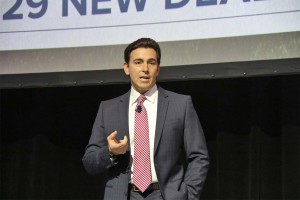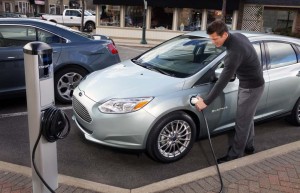Ford Motor plans to invest $4.5 billion to add an array of new hybrids, plug-ins and battery-electric vehicles to its line-up by the end of the decade, CEO Mark Fields announced on Thursday.
The maker plans not only to add more battery-based vehicles but also to expand where it will offer those models, with two new produced, the plug-in C-Max Energi and the Mondeo Hybrid, entering the Chinese market in the coming months.
By the end of the decade, said Fields, “More than 40% of our nameplates will be electrified,” up from 13% today, and the list will include “a full range” of the maker’s products, not just a limited selection like today. Where there are six battery-based products today, Ford will add 13 more by 2020.
Ford officials declined to go into specific details about which current models will offer battery options, and what sort of new products might be in the works, but they made it clear they don’t plan to leave opportunities to the competition. Among the likely targets will be upcoming, long-range battery-electric vehicles such as the Chevrolet Bolt and Tesla Model III.
“We fully anticipate we’ll be introducing vehicles with competitive range in both fully electric and plug-in hybrid forms,” said Raj Nair, Ford chief technology officer and head of its product development operations.
So-called “range anxiety” is considered one of the key obstacles to wider acceptance of battery-based products, especially pure battery-electric vehicles like the Ford Focus Electric. The maker plans to boost that model’s range to more than 100 miles when it is updated next year, the current model limited to 76 miles.
“Making this improvement is important,” said Stephanie Brinley, an auto analyst with IHS Automotive, but “200 miles appears to be the real breakthrough in terms of consumer acceptance.”
Brinley also said that consumers appear to want their battery-based models to charge more quickly. While many motorists leave their vehicles plugged in overnight, they don’t want to have to wait for hours on end if they need to travel during the daytime for an extended distance. Ford plans to address that problem by also adding a DC quick-charge feature to the updated Focus Electric – which will permit an 80% recharge in 30 minutes.
Cost is another issue that industry planners see as a critical challenge to more widespread acceptance of battery power. Manufacturers like Ford have cut the cost of models like the Focus Electric, Chevrolet Volt plug-in and pure battery-electric Nissan Leaf in recent years, but even sharper cuts could follow.
(Chevrolet Volt named Green Car of the Year. Click Here for the story.)
At the beginning of the decade, as the first mass market plug-ins and BEVs came to market, manufacturers were spending as much as $1,000 a kilowatt-hour for lithium-ion batteries. That is believed to be down to around $400 for most makers. But prices are falling rapidly.
GM product chief Mark Reuss recently told TheDetroitBureau.com that the maker expects to pay $150 for the basic cells in the Chevy Bolt battery pack, and Volkswagen officials said they anticipate a similar price tag for their BEV sport-ute coming in 2018.
Kevin Layden, who oversees powertrain electrification at Ford, said battery costs are “falling faster” than many had expected. And while CTO Nair declined to set a specific target price for Ford, he said “We’re very confident we’ll be competitive on the cost” with key competitors like GM and VW.
Not only are manufacturers increasing range and lowering the cost of battery-based models, but they are also improving performance. Early electrified vehicles could barely muster 0 to 60 times of 10 seconds. Porsche anticipates it will deliver a launch time of barely 3 seconds with the Mission E sports car it announced this week – even with a range of over 300 miles per charge.
“There is an opportunity for performance” in future Ford electrified products, hinted Nair. Indeed, several well-placed sources have suggested the maker is considering a hybrid option for the venerable Mustang in the near future.
(Click Here to check out Porsche’s new Mission E battery sports car.)
Ford’s electrification news might seem ill-timed to some observers, considering the sharp downturn in gasoline prices and the possibility of an even sharper plunge in the near future. That is one reason why demand for the maker’s current battery models has fallen by roughly 25% so far this year.
Company officials admitted they need to do a better job convincing consumers of the advantages of electric propulsion, but improvements in the technology should also enhance its appeal.
The reality is that Ford, like its competitors, may have no choice but to keep expanding its electric line-up. It has to cope not only with tougher European CO2 rules and U.S. mileage standards, but also the zero-emissions vehicle mandate in California. A maker that falls short could be banned from that huge market.
Nonetheless, Nair said Ford is confident buyers will be drawn to newer battery models and that Ford will be able to recoup the hefty investment it announced on Thursday. “That’s our intention,” to deliver a similar return on investment to what it is spending on more conventional products.
($20 a barrel oil? Fuel prices could plunge even further. Click Here for that breaking news.


